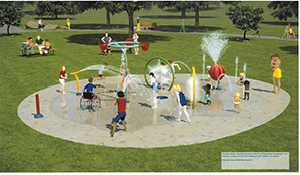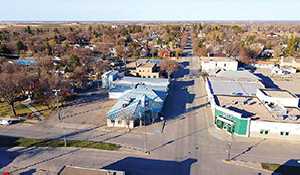13 Ways to Kill Your Community
January 7, 2020, 4:18 am
Kevin Weedmark


The following is a really brief summary of Doug Griffiths’ points in 13 Ways to Kill your community:
1. Water Quality
If water quality in a community is bad, the community is probably in sharp decline with businesses closing, empty houses for sale and a community that appears decrepit and unsightly. Nowadays, people view good quality water as an essential quality of life. Furthermore, many industries require good quality water to be sustainable, including agriculture and tourism.
If you want your community to fail, if you do not want to see it grow—just don’t bother to address the issue of water (supply, quality, safety, disposal, etc.)
2. Business Attraction
The more businesses and business competition in a community, the more likely it is to be sustainable. People like variety and choices and they are willing to drive an hour or more to get what they are looking for. Successful communities are very innovative in their efforts to retain and attract business to the community. They understand that businesses create jobs and expand the tax base; more shoppers means more revenue in the community.
If death of your community is the ultimate goal, don’t bother doing anything about attracting new people and new businesses to your community; don’t change your bylaws or do anything to entice business development.
3. Youth Involvement
The more young people (35 years and under) are encouraged to participate in recreation, culture, and community affairs, the more vibrant the community is likely to be. These people have energy and fresh ideas. I guess all you have to do is look at the average age of municipal councillors in Saskatchewan to see that ‘youth’ are not part of the leadership mix. Successful communities say that complacency and saying that youth aren’t interested are just excuses for not changing the old ways of thinking.
If stifling your community is your plan, continue not engaging youth, don’t find reasons for them to stay and don’t seek out and use their ideas.
4. Assessing Community Needs and Assets
You know the old saying, “fail to plan and you automatically plan to fail.” Well, that is especially true with communities. If you don’t take a critical look at the community needs and then plan step by step how to meet these needs; if you don’t take inventory of community assets and create opportunities and creative ways to use them to the community’s advantage, you are just taking up space while your community continues to decline.
If the failure of your community is the ultimate goal, just continue doing things the ways you have always done them while you continue to expect different results.
5. Shop Elsewhere
How many rural businesses do you know that actually seek their customers’ feedback on how the business could provide better service or better products? Of those that do, they probably also engage their consumers in conversations and demonstrate that the their customers are very valuable to them.
Don’t give local consumers a reason to shop local (poor service, don’t keep the business clean and attractive, high prices, putting the ‘guilt trip’ on customers for not buying locally, ‘bad mouth’ other businesses).
These are ‘sure fire’ ways your business community can decrease business, lose customers and jobs and eventually close their doors.
6. Appearance of Businesses and the Community At Large
It’s human nature to be drawn to attractiveness, whether aesthetically pleasing people or places.
We don’t usually buy houses, cars or clothes that are ugly. We don’t usually shop in businesses that are junky, disorganized and messy.
What effect do rundown, dirty, dimly lit and ‘shop worn’ businesses have on consumers? Well, people will actually pay twice as much for a product or service from a business that is nicely decorated, freshly painted, tidy and well organized….even if it means shopping outside of the community.
The same holds true with people’s reaction to communities with poorly lit streets, uncontrolled weeds and unsightly premises, cracked sidewalks, streets with potholes, poorly maintained civic and recreation facilities, damaged signage or lack of signage, lack of well groomed park areas and green spaces. There is no civic pride in an ugly community and this type of community is certainly where most newcomers would not want to live.
If the failure of your community is your ultimate goal, continue to make business and community aesthetics a low priority and you will no doubt be very successful in driving business and newcomers away from your community.
7. Co-operation
An essential requirement of all human relationships is co-operation (marriage, business, friendships, sports teams and work bees).
Another sure way of ensuring your community remains at a disadvantage is to refuse meaningful co-operation with other municipalities, organizations, businesses, etc. You can do this by ignoring activities, talents, efforts of other groups; you can actually pursue open conflict with other groups; or you can pretend to work with them while you ‘bad mouth’ them behind the scenes and follow your own hidden agenda. Any one of these is an excellent way to kill spirit and energy.
You can be assured of leading your community into a pattern of bullying, intimidation and hostility if you are determined and cunning enough.
8. Live in the Past
To have the ultimate goal of destroying your community (albeit unwittingly most of the time), requires just the right attitude. Although the previous 7 ways to kill off a community are mostly about attitude, living in the past and dwelling on past problems, mistakes and failures will infiltrate the entire community.
These type of folks are usually the most vocal in meetings, the coffee shop, the lounge and sitting around the council table.
They are very skilled at sucking the energy out of creative, forward thinkers. They much prefer arguing about failures than seeking out solutions for the future.
If strangling your community is the ultimate goal, negative attitude is essential.
Hold on to it, live by it and share your thoughts with everyone who will give you a moment’s attention.
9. Ignore the Seniors
Ensure that this large, dangerous group is kept in the background and not involved in the community in any way except at their own senior drop-in centre. Even though many of them have money, time on their hands, and are capable of contributing to the wellbeing of the community, many community leaders choose to ignore this community asset. However, successful communities capitalize on their senior population. They realize that seniors are consumers that contribute to the overall economy of the community. They want to be involved in building the community in which they live and want to be active, contributing members of the community. Successful communities don’t just keep their seniors, they attract others.
If you are bent on destroying your community, you are best to ignore the seniors. Warehouse them in old folks homes and don’t let them get too involved in the community. And definitely don’t cater to their needs. Out of sight, out of mind is the best approach.
10. Nothing New
If you want to keep your community down trodden and in its place, ignore anyone who brings up new ideas.
Communities that seek out ideas, explore options, exchange ideas and seek out ways of working with other communities, the private sector and other organizations discover a whole new world of opportunities.
Businesses often learn to be successful by following the practices of other successful businesses and by regularly seeking out suggestions from employees, suppliers and customers.
Imagine the chaos if a community employed similar practices!
No, you must continue using the same leaders, the same leadership styles and the same ideas over and over again while continuing to expect different results.
11. Ignore Immigrants and Newcomers
Don’t go out of your way to attract immigrants and newcomers.
They have such strange ideas and ways of doing things.
Besides, they dress funny and chatter in a language we can’t understand.
Now successful communities don’t take this approach.
They wholeheartedly welcome newcomers, including immigrants into their community.
They recognize the benefits of diversity, new skills, the newcomers’ work ethic, their entrepreneurial drive and their willingness to invest in their new community.
They are most appreciative to have the opportunity to be part of a safe community.
If you don’t want newcomers to get a foothold in your community, the best way to deal with these people is to keep them shut out of civic affairs, make little or no effort to integrate them into the social fabric of the community and keep them in the shabbiest of living conditions. After all, they are ‘transients.’ They don’t think like us, they seem to work all the time and they eat such strange foods—they are really weird. Make them feel different and excluded and, in due time, they will move somewhere else.
12. Take No Risks
By all means don’t take any risks….just keep tight purse strings on the budget and cut wherever you can each year.
Don’t even think about trying something that’s never been done before.
Taking risks and trying something new can lead to failure, so best just stick with what you have always done and let the government figure out what can be done to attract new people and business to rural communities.
Successful communities are not afraid to take risks and embrace change.
By being creative and taking on a ‘can do’ attitude, they find that one success leads to another and another.
If you like the status quo and have no stomach for risk taking, you’ll be in a good leadership position to keep your community away from all chances of being successful.
13. Don’t Take Responsibility
Lack of housing and financial resources, declining volunteerism, high taxes, increased vandalism, people moving to larger centres—are always someone else’s fault.
Is your cup half empty or half full? Positive thinking people see problems as an opportunity to make changes, develop new skills, make money, meet new people, create new partnerships, etc.
Negative people are unable to think beyond the problem, they tend to focus on everything that is wrong and have no problem-solving skills.
If you are determined to see your community fail, ensure you and everyone else you know does not take responsibility for any problems in your community….that way, no one will feel compelled to fix anything.
Whatever you do, find someone to blame.
Challenge them to fix the problems but don’t take on any responsibility yourself and definitely don’t ever offer to work with others to problem solve.
Doug Griffiths will be speaking on 13 Ways to Kill Your Community at the MCC Centre in Moosomin Monday, February 10. Tickets are available at the World-Spectator office (714 Main Street Moosomin, 306-435-2445) and at http://CFSunrise.eventbrite.com



































